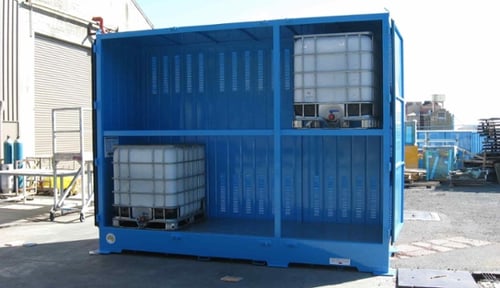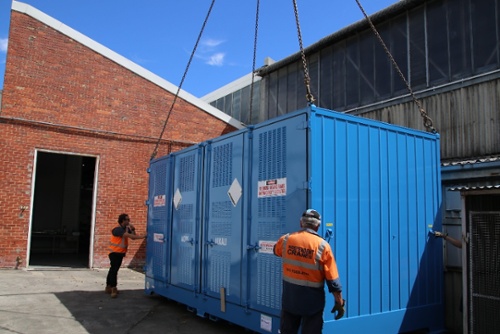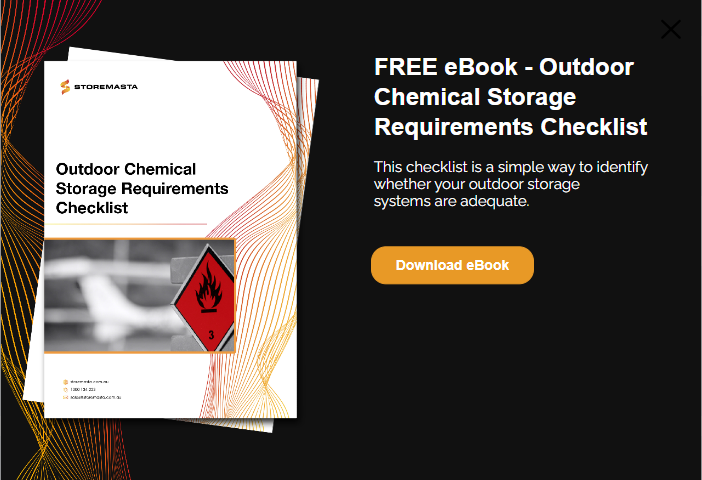If you’re in the market for dangerous goods storage containers, you’ve got a lot to consider. So, in this post, we thought we’d help you navigate the process by offering our expert tips on buying or hiring a DG container. With online businesses on the rise and an increased awareness about scams, it’s important that you do your research before you buy or hire your chemical storage equipment. Afterall, your dangerous goods storage container is designed to safeguard your business against the physical, psychological and financial costs of chemical hazards. Let’s get started with our 7 quick tips.
Tip 1. Check that the Dangerous Goods Container Meets Australian Standards
If you’ve read any of our blogs, you’ll understand the importance of selecting a chemical storage container that is designed and constructed in full conformance with the Australian Standards.
But for those of you who are uninitiated, here it goes:
The Australian Standards are detailed guides that offer comprehensive requirements for the handling and storage of dangerous goods. There are many different Australian Standards, with a Standard created specifically for each dangerous goods class.
Within these Standards, you will find a range of important information and stipulations that will help you safely handle and store your dangerous goods and hazardous chemicals.
In each of the Australian Standards, there is a specific section which relates to the construction of chemical stores.
These requirements may include specifications such as:
- Bunded spill containment sump
- Outdoor ventilation
- ISO locking bars for outdoor security
When choosing a DG container for your site, make sure that the product is designed and constructed in full conformance with Australian Standards.
This will allow your business to protect itself and its people from the hazards associated with the particular dangerous goods class that you’re looking to store.

If your container is constructed to meet Australian Standards, you’ll be hiring or purchasing storage equipment that offers the highest standard of chemical risk protection.
Tip 2. Will the DG Container Comfortably Fit your Chemical Packages?
Did you know that it’s often more cost-effective to purchase a larger DG storage container that can grow with your business? Larger containers often work out to be cheaper (per litre of storage), so it pays to compare models and prices to ensure you’re getting the best deal.
When choosing a container for your site, you will have to consider two key things about the actual chemicals that you’ll be storing:
- Will the chemical quantity be able to fit in the container without obstructing control measures such as doors or overcrowding shelves?
- Do the chemical packages that I’m storing fit well into the configuration of the container?
As there is a maximum storage capacity for all dangerous goods storage equipment, you must make sure that you’re not exceeding that limit when you’re stacking and loading your container.
Excessive packages will increase risk for your business, with the potential for a higher risk of hazardous and/or flammable vapours, as well as leaks and spillage.
You must also ensure that the sump capacity is compliant, so the chemical packages that you are storing are effectively contained in the event of a spill.
Like to learn more about controlling chemical risk?
Access our free eBook
Tip 3. Go With a Reputable Manufacturer or Supplier
If you’re hiring or buying from a legitimate business, then you should be able to easily access all their contact information, as well as their location and ABN.
To avoid purchasing through a company that may be unreputable — or worse, an online scam — you should do your research to determine the legitimacy of the company and their products.
It’s also a good idea to see if the company has quality assured systems in place, as this can provide peace-of-mind that their product and service will meet expectations.
You can also ask for a certificate of conformance to ensure that the containers are made to meet the Standards.
REMEMBER: We are Australia’s leading dangerous goods storage manufacturer and supplier, with 30 years in the industry. We are an ISO 9001 certified company with quality management systems that meet international standards.
Tip 4. Take into Account Delivery Costs and Timeframes
If you’re buying equipment online, you want to make sure that you’re taking into account the delivery cost of getting your dangerous goods storage container to your site.
As you can imagine, with an item this large (some containers can be 20ft in size!), heavy and bulky, the cost of delivery can add dollars to the purchase or hire price.
That’s why it’s highly recommended that you do your research before you hit the BUY button.
If you’re buying a container from overseas, there are many factors to consider. Apart from the fact that the container may not be constructed to meet the stringent requirements that we have here in Australia, the delivery cost and timeframe may create extra problems for your workplace.
Australian suppliers and manufacturers, on the other hand, can more easily get the container to your site within a more reasonable timeframe. That’s not to say that road transport for these DG solutions is fast or cheap – just that it is often more convenient and cost-effective than having a container imported from overseas.
You may also like to consider the costs associated with unloading. If you don’t have a forklift onsite that can do the job, you may need to hire a crane and operator.

Consider the logistics of getting the dangerous goods storage container to your site.
Tip 5. Has the Container Been Used Before?
If a container has been used before, it doesn’t mean that it can’t be used again. However, there are dangers associated with repurposing old containers that you need to be aware of.
These include:
- Make sure that the container is properly cleaned out, decontaminated and (if appropriate) neutralised before it’s used again
- Check the structural features of the container to ensure that it’s undamaged and in good working order
- Ensure that the chemical spill sump is compliant capacity and working as it should, without corrosion, holes or any other issues
- Check that the container is stable and that the footing is still creating a strong, level base
- Inspect the natural ventilation system of the container, so ensure that there is the free flow of air throughout the container
- Do the shelves require a replacement; do they need to be moved to accommodate your chemical packages
- Is the dangerous goods and hazard signage in place?
- Is there a security mechanism to prevent unathorised entry to the container?
If you’re hiring a dangerous goods storage container from a reputable supplier, all of these important safety factors should already be taken care of prior to the container being dispatched to your business.
However, if you’re purchasing from a friend of a friend, or off a website such as Gumtree, always do your research to ensure that your ‘good deal’ is actually worthwhile.
Tip 6. Will the Container Last?
There’s no point snagging a deal for a dangerous goods container if it turns out that the container is not a quality product.
When it comes to hazardous chemical storage, the quality of the construction is directly linked to the effectiveness of the product and its ability to control risks in your workplace.
The materials and fittings used to create the container — in addition to the actual design and construction of the equipment — can make the difference between a DG container lasting 5 years or 15 years.
Remember, unlike indoor chemical storage cabinets, dangerous goods containers are meant to be kept outdoors.
This means that your container will have to withstand:
- Corrosion from sea breezes
- Impact damage during storms
- Cyclones and strong winds
- Rainfall
- Possible extreme temperatures
- Direct sunlight
There are many ways that manufacturers can ensure that their dangerous goods storage containers will go the distance. These include using robust steel with a high build polyurethane paint, which can improve the longevity of your equipment in the harsh outdoor environment. Look for containers with a weatherproof design and opt for a higher cyclone rating if you work in a cyclone-prone location.
Tip 7. Ensure the DG Container is Easy to Relocate
While your dangerous goods storage container is designed to be an easily relocatable solution, some models are far simpler to move than others.
Look out for containers with features including forklift pockets and a certified lifting capacity. This will allow you to relocate your chemical storage containers in a safer manner. Some containers can also be lifted when full, which can speed up work tasks on busy job sites by removing the need to unload and reload the DG container.
Stackable dangerous goods containers are also a convenient option for businesses that are tight on outdoor space. Having the potential to easily move and stack your outdoor DG containers allows you to customise your storage needs, while improving site safety when relocating your store.

How easy it is to relocate and stack your containers is an important factor to consider if you want convenience and flexibility with your chemical stores.
Buying or Hiring a Container?
We hope you’ve found out 7 top tips for buying or hiring a dangerous goods storage container helpful. However, there’s more to learn about outdoor storage if you want to keep your organisation free of chemical risk. Why not access our handy Outdoor Storage Checklist to see if you’ve ticked off all the necessary controls for your dangerous goods and hazardous chemicals. Grab your copy for free today.
Joining the team as a Dangerous Goods Storage Consultant, Melissa Hampton became Storemasta's Marketing Manager in late 2021. With extensive knowledge and experience in chemical compliance, Melissa is responsible for leading the Marketing team and helping shape their marketing strategy. In her spare time, you can find Melissa hiking, swimming and enjoying the great outdoors in beautiful north-west Tasmania.
